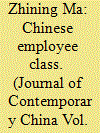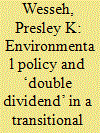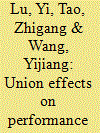|
|
|
Sort Order |
|
|
|
Items / Page
|
|
|
|
|
|
|
| Srl | Item |
| 1 |
ID:
100351


|
|
|
|
|
| Publication |
2010.
|
| Summary/Abstract |
As the 'World's Factory', China now has the biggest worker/employee class in the world. Though this newly emerging social group has captured much attention, relatively few scholars have paid attention to such sociological questions as raised by this paper: rather than referring to such a huge group of almost 500 million people simply as 'Chinese workers' or 'Chinese employees', can this social class be stratified and in what way? What is the current situation of the employee class in China's contemporary industrial relations? This paper attempts to concisely answer the above questions by proposing a three dichotomy segmentation approach and a review of the existing literature on the matter, providing a broader picture to the readers with regards to the current situations of different employee groups in the context of China's unprecedented transitional economy.
|
|
|
|
|
|
|
|
|
|
|
|
|
|
|
|
| 2 |
ID:
169734


|
|
|
|
|
| Summary/Abstract |
Although the environmental benefit from implementing a climate tax is usually realized, the economic dividend still remains a controversial issue warranting further research. This is because the impact of an environmental policy on an economy-wide system will depend on factors that differ from one region to the next. In this paper, we develop a static CGE model for Liberia that is capable of analyzing both a uniform and a partial carbon tax policy. Under the uniform policy instituted to ensure mitigation in the range of 20–50%, an economic dividend is found for energy, employment, and welfare. In particular, energy consumption increases by between 5 and 15.5%, respectively. Interestingly, under a second best policy which exempts economically strategic sectors from the tax, no economic dividend is found for all three variables. This time, energy use declines by between 2 and 9%. These suggest that a uniform environmental tax policy is a more viable option for Liberia, in particular, as it does not only generate economic dividend for employment and welfare, it also incentivizes Liberia's adoption and use of renewable energy technologies. In general, based on the results obtained, further conditions for the feasibility of a double dividend are proposed.
|
|
|
|
|
|
|
|
|
|
|
|
|
|
|
|
| 3 |
ID:
101200


|
|
|
|
|
| Publication |
2010.
|
| Summary/Abstract |
The growth and transformation of state-owned enterprises (SOEs) in a changing socialist China has long been a popular focus of scholarly attention.Relatively little has been done to explain the growth dynamics and regional variation of China's SOEs. This paper investigates the spatial variation of China's SOEs through a comparative analysis of SOEs in northeast and southChina. A detailed comparison of SOEs in the machinery industry sector located in Shenyang in the northeast and Guangzhou in the south has revealed an interesting pattern inwhich SOEs in the two locations were positioned in different production environments characterized by different norms of market competition and different types of political ties with the central state. The non-price norm of market competition and a political commitment to a state strategy of key equipment indigenization have provided incentives for SOEs in Shenyang to adopt a technically-oriented and independent-brand-based growth strategy in their direct engagements with transnational corporations, and these engagements have caused them to pursue the rapid expansion of production capacity and sales income at the expense of capital efficiency and external economies. In contrast, the pressures ofmarket competition plus hardened budget constraints enforced by local governments has forced SOEs in Guangzhou to fall back on externally malleable production linkages and inter-firm networks, which have enabled them to adapt to emerging markets during the economic transition. While SOEs in the two locations share the same public property rights arrangements and operate in the same industrial sector, they are actually "different dreams" within the "same bed."
|
|
|
|
|
|
|
|
|
|
|
|
|
|
|
|
| 4 |
ID:
093854


|
|
|
|
|
| Publication |
2010.
|
| Summary/Abstract |
This paper empirically studies union effects on the performance of, and employment relations in, China's private enterprises. The study finds a positive and statistically significant union effect on labor productivity, but not on profitability. It further finds that unions lead to better employee benefits and increased contract signing in employment. These findings suggest that, in the era of transition from a centrally planned to a market economy, unions in China's private enterprises do promote workers' interests as unions do in other economies. And they do that without abandoning their traditional role of harmonizing employment relations, as required by the Party.
|
|
|
|
|
|
|
|
|
|
|
|
|
|
|
|
|
|
|
|
|